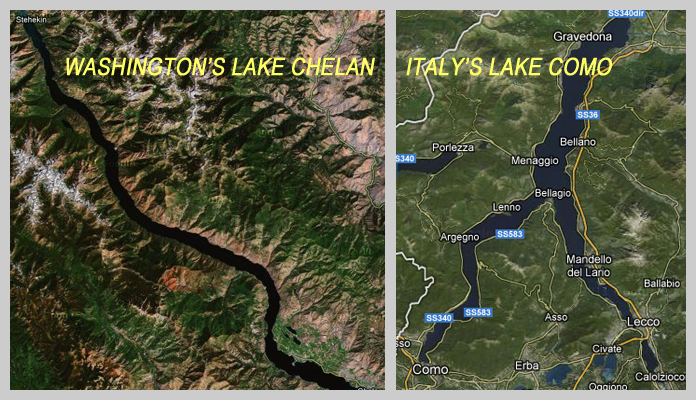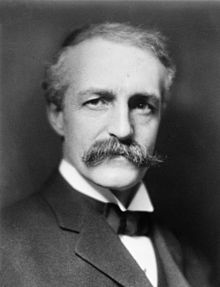Lake Chelan, often mistaken for an Italian lago
I’m reading (actually, listening to) a book called The Big Burn: Teddy Roosevelt and the Fire that Saved America by Timothy Egan. In it, Gifford Pinchot comments that Washington State’s Lake Chelan bears a striking resemblance to Italy’s Lago di Como (Lake Como). I thought that was interesting so I put together this little side-by-side comparison thanks to the technological marvel that is Google Maps. What do you think? Does Chelan look like Como?

Like a mirror image…
The book was a recommendation of Nancy Barker, a Washington State Department of Natural Resources employee I had the pleasure of working with while doing some volunteer trail repair. I decided to read the book for three reasons…first, while doing the trail repair I was using a tool called a Pulaski and the book chronicles the efforts of the man this particular tool was named after. Second, the story takes place here in the Pacific Northwest and talks about a lot of towns I’ve actually been to. Third, it focuses heavily on Teddy Roosevelt and Gifford Pinchot…two men I’ve been reading about a lot lately and I wanted to read more. Especially Pinchot.

Gifford Pinchot
Gifford Pinchot is probably best known in Washington State for the national forest that is named after him, Mt. Saint Helens being the best known landmark in the center of the Gifford Pinchot National Forest. Pinchot was the nation’s first forester, the father of our country’s national forests and the central driving force behind the creation of the United States Forest Service. Pinchot and Teddy Roosevelt were good friends with common interests in the outdoors, and together they helped secure the land that we are able to enjoy to this very day.
Without the combined efforts of Roosevelt and Pinchot, the timber barons, clearcutters, strip miners, and environmental opportunists of the late 19th century would likely have destroyed all the beautiful natural habitat that the western United States enjoys. Granted, there were a number of other key players in the segregation of these national forests…Presidents Grover Cleveland and William McKinley, the park-designing Olmsted brothers, and preeminent outdoorsman John Muir to name a few…but Pinchot and Roosevelt are generally credited as the movers and shakers of the national forest movement.
The book, The Big Burn, chronicles the activities of Roosevelt and Pinchot as they lead up to the great fire of 1910. Any Washington State or Pacific Northwest history buff, outdoor enthusiast or anyone with a general interest in the American story should read (okay, or listen to) this book. Here’s a synopsis from Amazon (note that the fire began on MY BIRTHDAY in 1910!):
On the afternoon of August 20, 1910, a battering ram of wind moved through the drought-stricken national forests of Washington, Idaho, and Montana, whipping the hundreds of small blazes burning across the forest floor into a roaring inferno that jumped from treetop to ridge as it raged, destroying towns and timber in the blink of an eye. Forest rangers had assembled nearly ten thousand men to fight the fires, but no living person had seen anything like those flames, and neither the rangers nor anyone else knew how to subdue them. Egan recreates the struggles of the overmatched rangers against the implacable fire with unstoppable dramatic force, and the larger story of outsized president Teddy Roosevelt and his chief forester, Gifford Pinchot, that follows is equally resonant. Pioneering the notion of conservation, Roosevelt and Pinchot did nothing less than create the idea of public land as our national treasure, owned by every citizen. Even as TR’s national forests were smoldering they were saved: The heroism shown by his rangers turned public opinion permanently in favor of the forests, though it changed the mission of the forest service in ways we can still witness today.
That brings me back to the point of this blog post…Pinchot off-handedly commented that our Lake Chelan reminded him of Italy’s Lake Como. While jogging yesterday and listening to the book, I heard that snippet and decided to check it out. While Pinchot’s observation was made in the late 1800’s and based on nothing more than his keen visual observation, thanks to the evolution of satellite mapping technology here in the 21st century, I decided to use two Google Map snapshots to compare the two.
And yes, I can definitely see a likeness between the two lakes. Do you? Pretty spot-on for a 19th century world traveler.

Thanks, Josiah! We love Lake Chelan, too!
Yes, I’ve heard this as well. I LOVE lake chelan, and can’t really imagine that any other lake could compare to it, but have heard that lake como is possibly a close second place. I would suggest reading The Greatest Lake in the World by John Fahey; its got lots of great info about the two lakes, and a lot of other lakes as well.
I enjoyed your article!
-Josiah Montgomery
Pingback: Campbell’s Resort has something for everyone | Washington, Our Home
I am glad you enjoyed the book.